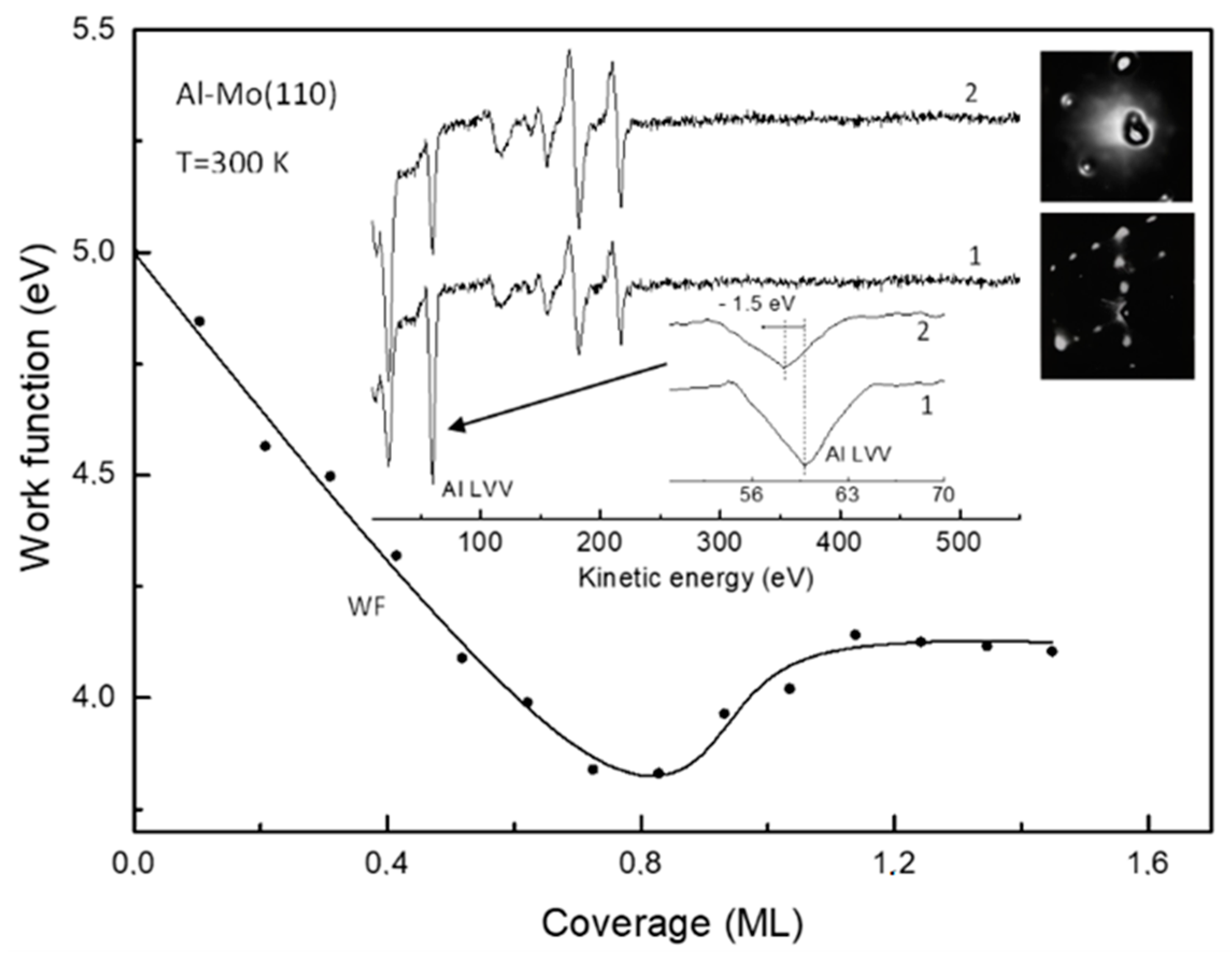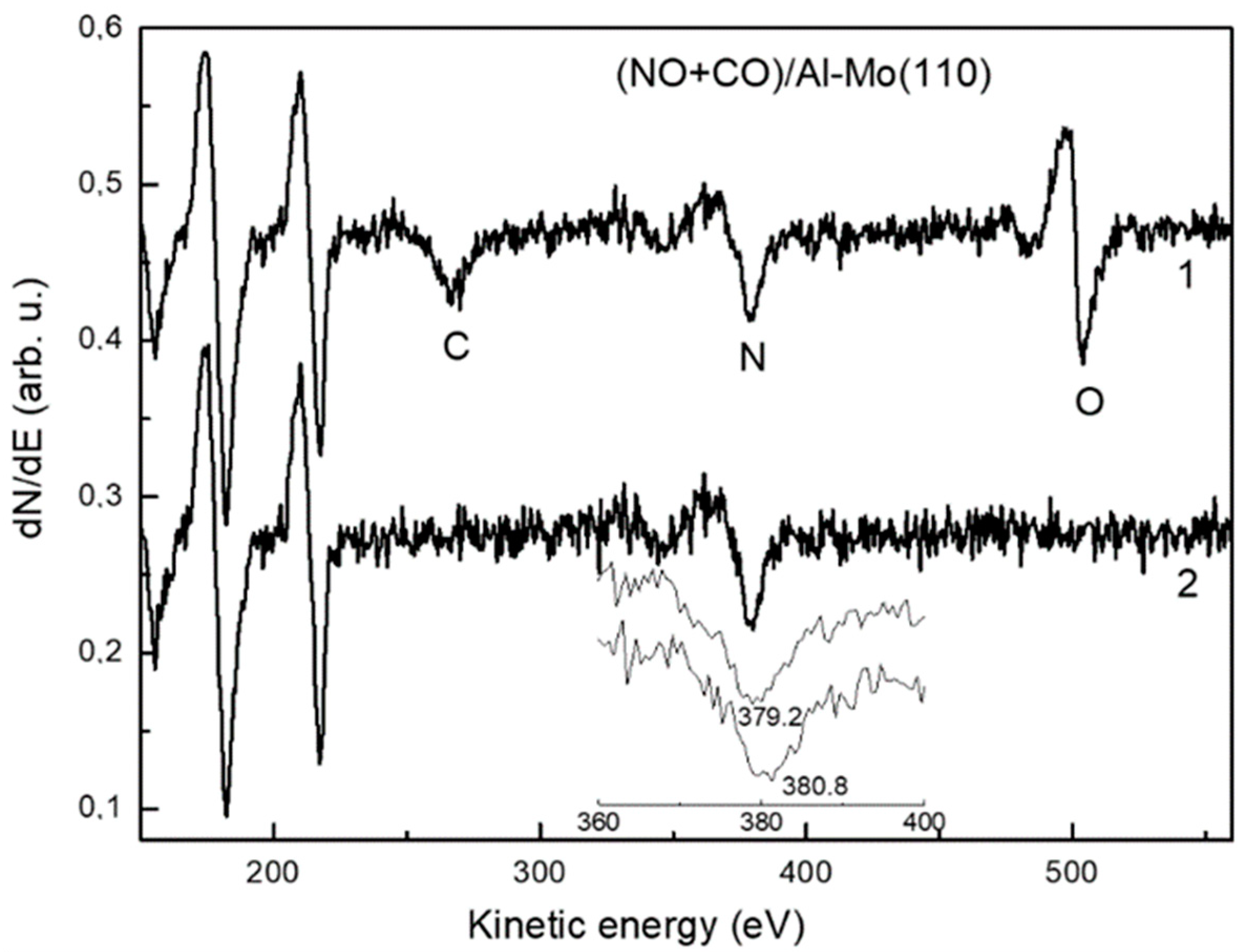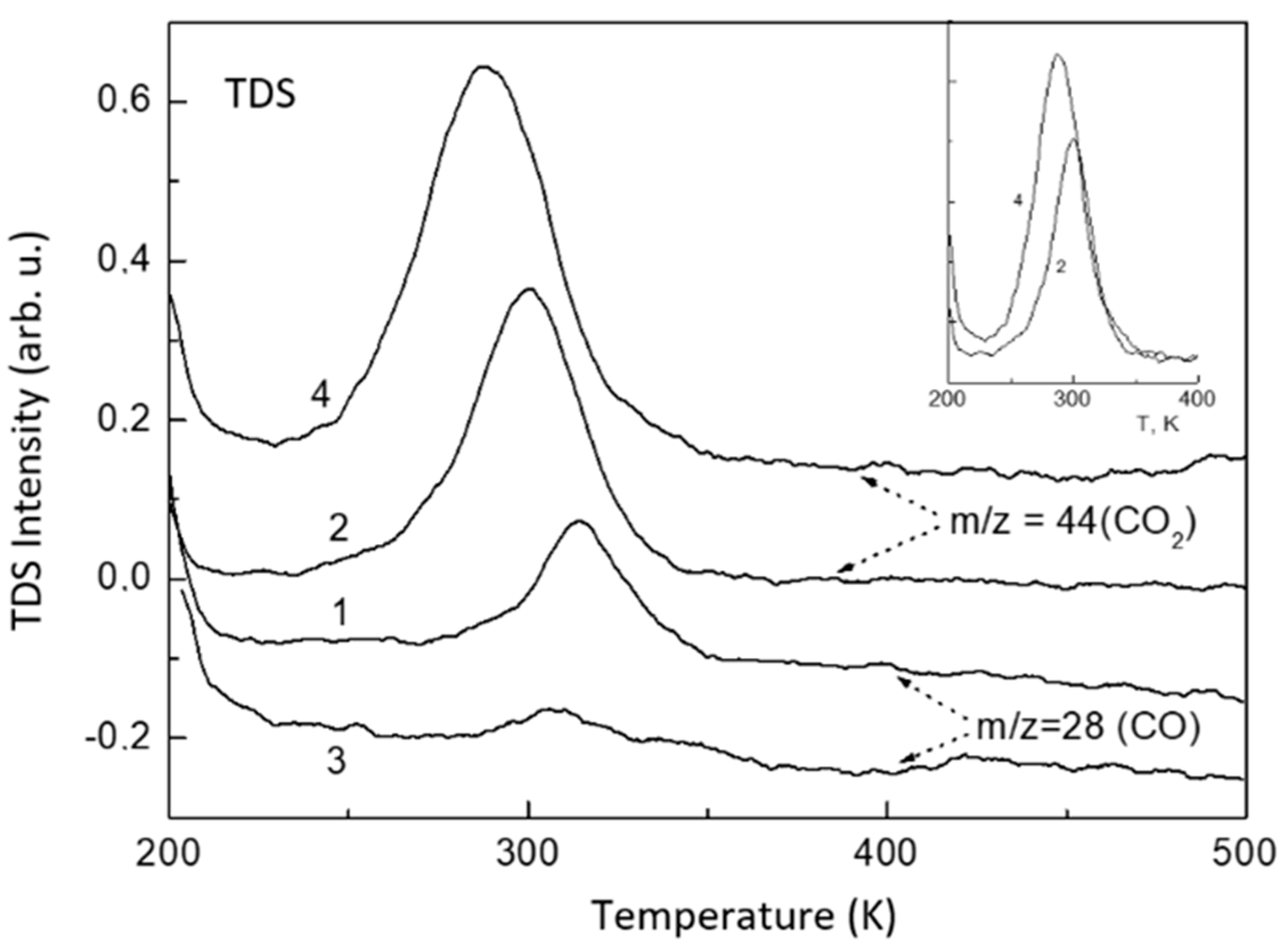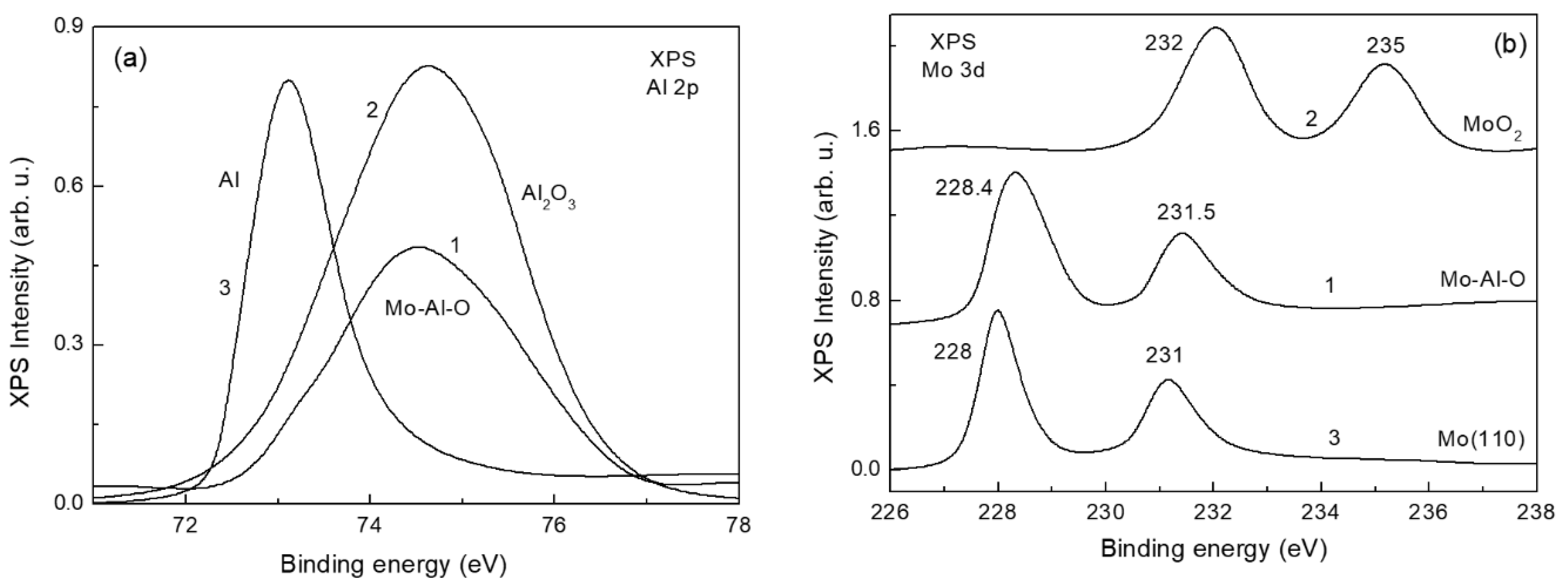Preparation of Aluminum–Molybdenum Alloy Thin Film Oxide and Study of Molecular CO + NO Conversion on Its Surface
Abstract
1. Introduction
2. Experimental
3. Results and Discussion
4. Conclusions
Author Contributions
Funding
Data Availability Statement
Acknowledgments
Conflicts of Interest
References
- Chen, S.; Xiong, F.; Huang, W. Surface chemistry and catalysis of oxide model catalysts from single crystals to nanocrystals. Surf. Sci. Rep. 2019, 74, 100471. [Google Scholar] [CrossRef]
- Chen, J.G.; Menning, C.A.; Zellner, M.B. Monolayer bimetallic surfaces: Experimental and theoretical studies of trends in electronic and chemical properties. Surf. Sci. Rep. 2008, 63, 201–254. [Google Scholar] [CrossRef]
- Shustorovich, E.; Baetzold, R.C. Toward a coherent theory of chemisorption. Science 1985, 227, 876–881. [Google Scholar] [CrossRef] [PubMed]
- Führer, M.; van Haasterecht, T.; Bitter, J.H. Molybdenum and tungsten carbides can shine too. Catal. Sci. Technol. 2020, 10, 6089–6097. [Google Scholar] [CrossRef]
- Ma, Y.; Guan, G.; Hao, X.; Cao, J.; Abudul, A. Molybdenum carbide as alternative catalyst for hydrogen production—A review. Renew. Sustain. Energy Rev. 2017, 75, 1101–1129. [Google Scholar] [CrossRef]
- Rochana, P.; Wilcox, J. A theoretical study of CO adsorption on FeCo(100) and the effect of alloying. Surf. Sci. 2011, 605, 681. [Google Scholar] [CrossRef]
- Dongil, A.B. Recent progress on transition metal nitrides nanoparticles as heterogeneous catalysts. Nanomaterials 2019, 9, 1111. [Google Scholar] [CrossRef]
- Choi, J.-G.; Brenner, J.R.; Calling, C.W.; Demczyk, B.G.; Dunning, J.L.; Thompson, L.T. Synthesis and characterization of molybdenum nitride hydrodenitrogenation catalysts. Catal. Today 1992, 15, 201–222. [Google Scholar] [CrossRef]
- Xua, Y.; Duan, J.-J.; Yi, Z.-Y.; Zhang, K.-X.; Chen, T.; Wang, D. Chirality of molecular nanostructures on surfaces via molecular assembly and reaction: Manifestation and control. Surf. Sci. Rep. 2021, 76, 100531. [Google Scholar] [CrossRef]
- Wang, J.; Castonguay, M.; Deng, J.; McBreen, P.H. RAIRS and TPD study of CO and NO on β-Mo2C. Surf. Sci. 1997, 374, 197. [Google Scholar] [CrossRef]
- Koverga, A.A.; Florez, E.; Dorkisa, L.; Rodriguez, J.A. Promoting effect of tungsten carbide on the catalytic activity of Cu for CO2 reduction. Phys. Chem. Chem. Phys. 2020, 22, 13666–13679. [Google Scholar] [CrossRef]
- Tvauri, I.V.; Khubezhov, S.A.; Demeev, Z.S.; Turiev, A.M.; Tsidaeva, N.I.; Magkoev, T.T. Carbon monoxide dissociation to oxidation surface reaction pathway shift on Mo(110) upon alloying with boron. Vacuum 2013, 88, 8–10. [Google Scholar] [CrossRef]
- Kolaczkiewicz, J.; Hoch, M.; Zuber, S. LEED, AES, Δφ and EELS study of Al on Mo(110). Surf. Sci. 1991, 247, 284. [Google Scholar] [CrossRef]
- Adachi, S. Lattice thermal conductivity of group-IV and III–V semiconductor alloys. J. Appl. Phys. 2007, 102, 063502. [Google Scholar] [CrossRef]
- Jackson, A.G.; Hooker, M.P. Auger/LEED investigation of the deposition of Al onto the Mo(110) surface. Surf. Sci. 1971, 28, 373. [Google Scholar] [CrossRef]
- Muscat, J.P.; Newns, D.M. Atomic theory of work function variation in alkali adsorption on transition metals. Solid State Commun. 1972, 11, 737. [Google Scholar] [CrossRef]
- Singh, R.N.; Brown, D.M.; Kim, M.J.; Smith, G.A. Study of molybdenum-aluminum interdiffusion kinetics and contact resistance for VLSI applications. J. Appl. Phys. 1985, 58, 4598. [Google Scholar] [CrossRef]
- Pogodin-Alekseev, G.I. Classification of binary alloys and their phase diagrams by the type of transformations occurring in them. Met. Sci. Heat Treat. 1967, 9, 39–43. [Google Scholar] [CrossRef]
- Ivkov, J.; Salamon, K.; Radic, N.; Soric, M. Thermal stability of Al–Mo thin film alloys. J. Alloys Comp. 2015, 646, 1109. [Google Scholar] [CrossRef]
- Campbell, C.T.; Goodman, D.W. Interaction of aluminum with the Ru(0001) surface. J. Phys. Chem. 1988, 92, 2569. [Google Scholar] [CrossRef]
- Larsen, J.H.; Chorkendorff, I. From fundamental studies of reactivity on single crystals to the design of catalysts. Surf. Sci. Rep. 1999, 35, 163–222. [Google Scholar] [CrossRef]
- Ren, J.; Wang, J.; Huo, C.-F.; Wen, X.-D.; Cao, Z.; Yuan, S.; Li, Y.; Jiao, H. Adsorption of NO, NO2, pyridine and pyrrole on α-Mo2C(0001): A DFT study. Surf. Sci. 2007, 601, 1599. [Google Scholar] [CrossRef]
- Matolin, V.; Stara, I.; Tsud, N.; Johanek, V. XPS and TDS study of CO interaction with Pd–AlOx systems. Progr. Surf. Sci. 2001, 67, 167. [Google Scholar] [CrossRef]
- Hammer, B.; Morikawa, Y.; Norskov, J.K. CO chemisorption at metal surfaces and overlayers. Phys. Rev. Lett. 1996, 76, 2141. [Google Scholar] [CrossRef] [PubMed]
- Hirschmugl, C.J. Frontiers in infrared spectroscopy at surfaces and interfaces. Surf. Sci. 2002, 500, 577–604. [Google Scholar] [CrossRef]
- Fukutani, K.; Magkoev, T.T.; Murata, Y.; Terakura, K. Adsorption and desorption of NO and CO on a Pt(111)-Ge surface alloy. Surf. Sci. 1996, 363, 185. [Google Scholar] [CrossRef]
- Magkoev, T.T. Coadsorption of nitric oxide and carbon monoxide on the nickel clusters deposited onto MgO(111) film formed on Mo(110). Solid State Commun. 2004, 132, 93. [Google Scholar] [CrossRef]
- Beniya, A.; Isomura, N.; Hirata, H.; Watanabe, Y. Displacement reaction of CO by NO on the Ni(111) surface. Surf. Sci. 2013, 613, 28. [Google Scholar] [CrossRef]
- Hendershot, R.E.; Hansen, R.S. Reduction of nitric oxide with carbon monoxide on the Rh(100) single-crystal surface. J. Catal. 1986, 98, 150. [Google Scholar] [CrossRef][Green Version]
- Johanek, V.; Stara, I.; Matolín, V. Role of Pd–Al bimetallic interaction in CO adsorption and catalytic properties of bulk PdAl alloy: XPS, ISS, TDS, and SIMS study. Surf. Sci. 2002, 507, 92–98. [Google Scholar] [CrossRef]
- Wang, Z.X.; Qiao, Q.-A.; Chen, S.G.; Zhang, W.X. The adsorption of O and CO on low index Ni planes and stepped nickel surfaces. Surf. Sci. 2002, 517, 29–42. [Google Scholar] [CrossRef]
- Saito, M.; Anderson, R.B. The activity of several molybdenum compounds for the methanation of CO. J. Catal. 1980, 63, 438. [Google Scholar] [CrossRef]
- Schaidle, J.A.; Thompson, L.T. Fischer–Tropsch synthesis over early transition metal carbides and nitrides: CO activation and chain growth. J. Catal. 2015, 29, 325. [Google Scholar] [CrossRef]
- Chen, P.J.; Goodmann, D.W. Epitaxial growth of ultrathin Al2O3 films on Ta(110). Surf. Sci. 1994, 312, L767. [Google Scholar] [CrossRef]
- Radican, K.; Berdunov, N.; Shvets, I.V. Studies of the periodic faceting of epitaxial molybdenum oxide grown on Mo(110). Phys. Rev. B. 2008, 77, 085417. [Google Scholar] [CrossRef]
- Natishan, P.M.; McCafferty, E.; Hubler, G.K. The corrosion behavior of Mo-Al, Cr-Al and Cr-Mo-Al surface alloys produced by ion beam mixing and ion implantation. Corrosion Sci. 1991, 32, 721. [Google Scholar] [CrossRef]
- Zhang, J.; Medlin, J.W. Catalyst design using an inverse strategy: From mechanistic studies on inverted model catalysts to applications of oxide-coated metal nanoparticles. Surf. Sci. Rep. 2018, 73, 117–152. [Google Scholar] [CrossRef]
- Magkoev, T.T. Interaction of carbon monoxide and oxygen at the surface of inverse titania/Au model catalyst. Surf. Sci. 2007, 601, 3143–3148. [Google Scholar] [CrossRef]
- Stottlemyer, A.L.; Kelly, T.G.; Meng, Q.; Chen, J.G. Reactions of oxygen-containing molecules on transition metal carbides: Surface science insight into potential applications in catalysis and electrocatalysis. Surf. Sci. Rep. 2012, 67, 201–232. [Google Scholar] [CrossRef]





Publisher’s Note: MDPI stays neutral with regard to jurisdictional claims in published maps and institutional affiliations. |
© 2022 by the authors. Licensee MDPI, Basel, Switzerland. This article is an open access article distributed under the terms and conditions of the Creative Commons Attribution (CC BY) license (https://creativecommons.org/licenses/by/4.0/).
Share and Cite
Magkoev, T.T.; Mustafaeva, D.G.; Zaalishvili, V.B.; Ashkhotov, O.G.; Sozaev, Z.T. Preparation of Aluminum–Molybdenum Alloy Thin Film Oxide and Study of Molecular CO + NO Conversion on Its Surface. Materials 2022, 15, 2245. https://doi.org/10.3390/ma15062245
Magkoev TT, Mustafaeva DG, Zaalishvili VB, Ashkhotov OG, Sozaev ZT. Preparation of Aluminum–Molybdenum Alloy Thin Film Oxide and Study of Molecular CO + NO Conversion on Its Surface. Materials. 2022; 15(6):2245. https://doi.org/10.3390/ma15062245
Chicago/Turabian StyleMagkoev, Tamerlan T., Dzhamilya G. Mustafaeva, Vladislav B. Zaalishvili, Oleg G. Ashkhotov, and Zaurbek T. Sozaev. 2022. "Preparation of Aluminum–Molybdenum Alloy Thin Film Oxide and Study of Molecular CO + NO Conversion on Its Surface" Materials 15, no. 6: 2245. https://doi.org/10.3390/ma15062245
APA StyleMagkoev, T. T., Mustafaeva, D. G., Zaalishvili, V. B., Ashkhotov, O. G., & Sozaev, Z. T. (2022). Preparation of Aluminum–Molybdenum Alloy Thin Film Oxide and Study of Molecular CO + NO Conversion on Its Surface. Materials, 15(6), 2245. https://doi.org/10.3390/ma15062245






